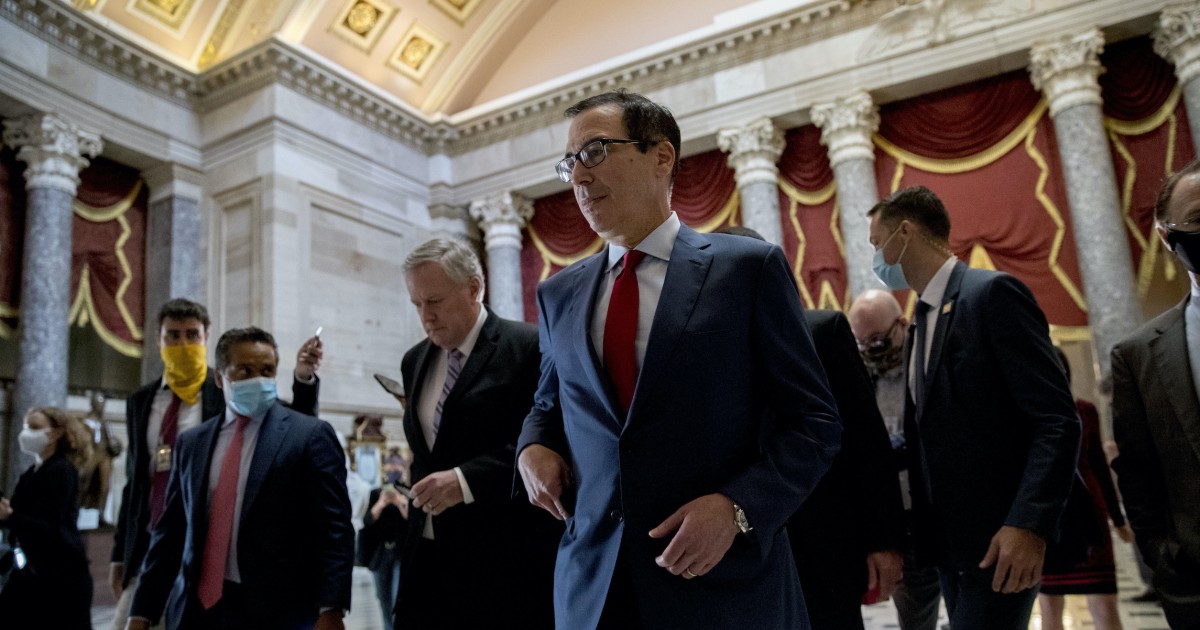
Negotiations on the next coronavirus economic relief package between White House officials and Democratic leaders broke down Friday after 10 days of failed talks.
“I told them: Come back when you are ready to give us a higher number,” House Speaker Nancy Pelosi said Friday after a meeting with Treasury Secretary Steve Mnuchin and White House chief of staff Mark Meadows.
Mnuchin and Meadows are poised to advise President Trump to take executive action, though it remains unclear as to how he would be able to redirect funding given he does not control federal spending.
Democrats said earlier Friday that they would be willing to shave $ 1 trillion off the $ 3.4 trillion deal by shortening the time frame of benefits without reducing demands. Neither Democrats nor Meadows were willing to remove any spending items from their proposals.
Trump accused Pelosi and Senate Minority Leader Chuck Schumer Friday of wanting to provide “bailout money” for “poorly run” blue cities and states.
“Nothing to do with China Virus! Want one trillion dollars. No interest,” Trump said. “We are going a different way!”
Pelosi and Schumer only interested in Bailout Money for poorly run Democrat cities and states. Nothing to do with China Virus! Want one trillion dollars. No interest. We are going a different way!
— Donald J. Trump (@realDonaldTrump) August 7, 2020
While talks failed on Capitol Hill, the total number of coronavirus cases in the United States ticked up to 4.9 million, according to data maintained by Johns Hopkins University. More than 160,000 people have died.
New York Gov. Andrew Cuomo announced Friday that public schools can reopen for in-person classes next month, as the coronavirus infection rate has remained below 3%, a threshold determined by the World Health Organization to be the safest for all reopening measures, since the end of July.
“Every region is well below our COVID infection limit; therefore, all school districts are authorized to open,” Cuomo said.
While New York City schools, the largest school district in the country, may reopen for in-person classes, other large school districts across the country will begin the school year completely online. Los Angeles, Chicago, Miami, and Houston schools will reopen for remote classes.
Florida Gov. Ron DeSantis has pressed school districts to reopen for in-person classes later this month, but the decision is ultimately up to local leadership and superintendents. Florida has become the coronavirus epicenter, with a test positivity rate of about 18%.
The economy gained 1.8 million jobs in July, lowering the unemployment rate to 10.2%, the Labor Department reported. Though the unemployment rate dropped 0.9% from June, it is currently far higher than the rate from February before the pandemic began, 3.5%. Still, the number of permanent job losses in July, 2.9 million, was slightly lower than the number in June.
On Friday, Hawaii Gov. David Ige reinstated an interisland travel ban for 14 days in response to a surge of coronavirus cases. Honolulu Mayor Kirk Caldwell also closed down all beaches in Oahu, although people will still be permitted to cross the beach to get to the water for surfing, fishing, paddling, and diving. Bowling alleys, arcades, and mini golf will also be closed. Gyms can remain open but may not teach multiperson classes. Hawaii experienced an increase of 200 cases on Thursday.
Massachusetts Gov. Charlie Baker announced Friday that he will pause the state’s reopening and will place new restrictions on gatherings indoors and outdoors, citing clusters of new cases throughout the state.
“While we’ve seen a decrease in #COVID19MA cases + hospitalizations since May, there’s been a slight uptick in certain communities in recent days,” Baker tweeted on Friday.
Baker is updating the restrictions on gathering sizes, reducing the limit on outdoor gatherings from 100 to 50 people starting on Tuesday. The limit on indoor gatherings will remain at 25 people. Face masks will be required at gatherings of 10 or more people. He will also form a multi-agency coalition with police officials to crack down on public health violations in order to prevent a resurgence in cases across the state.
About nine hours after testing positive for COVID-19, Ohio Gov. Mike DeWine took a more sensitive type of diagnostic test that came back negative. The false-positive could renew feelings of mistrust that the public has in health experts about the severity of the pandemic.
DeWine said he would be taking another PCR test on Saturday “out of an abundance of caution” to ensure he does not have the virus.
A California judge issued a temporary restraining order against the Godspeak Calvary Chapel near Los Angeles for defying Gov. Gavin Newsom’s ban on indoor worship services in an effort to limit the spread of the coronavirus.
“The Constitution is not a suicide pact,” Ventura County Judge Matthew Guasco said. “The exercise of individual liberties has to be consistent with public health, otherwise the one would cancel out the other.”
South Dakota’s Sturgis Motorcycle Rally is expected to bring in 250,000 people despite guidance from public health officials against large gatherings of people. The Sturgis City Council decided not to postpone the rally because of pressure from businesses, but more than half of the city’s residents believe it should be postponed.
“This is a huge, foolish mistake to make to host the rally this year,” Sturgis resident Linda Chaplin told the City Council at a June meeting. “The government of Sturgis needs to care most for its citizens.”
